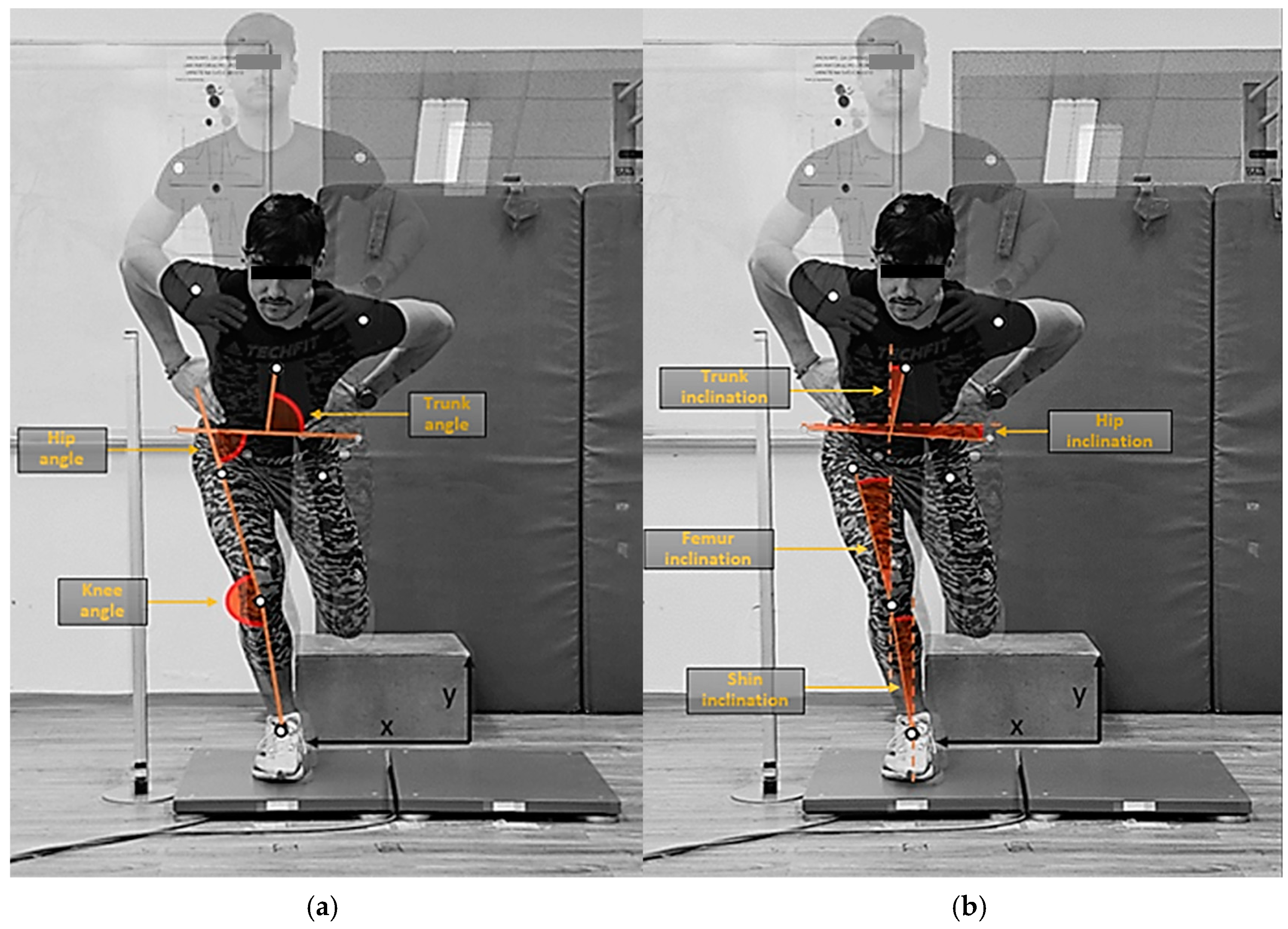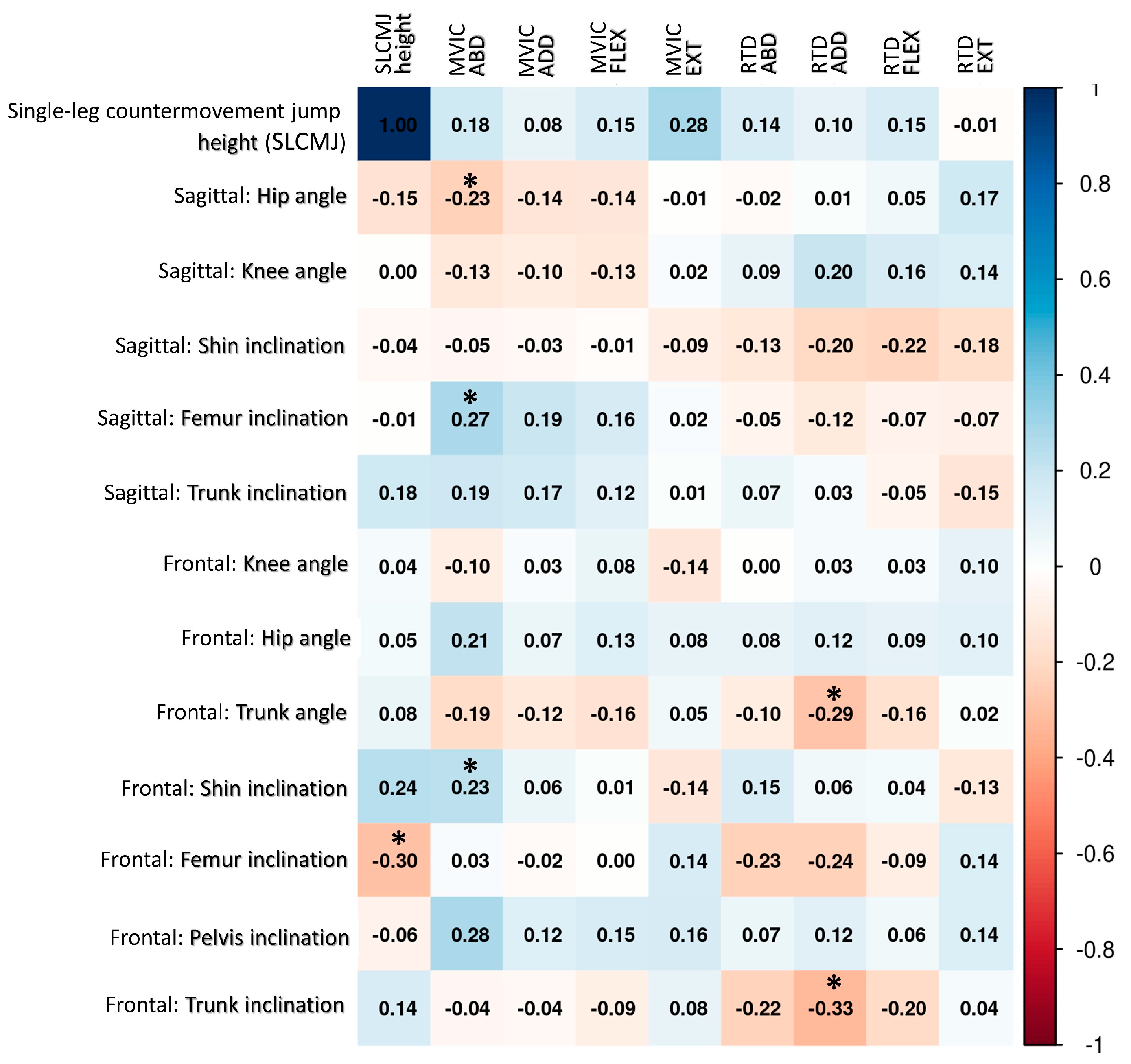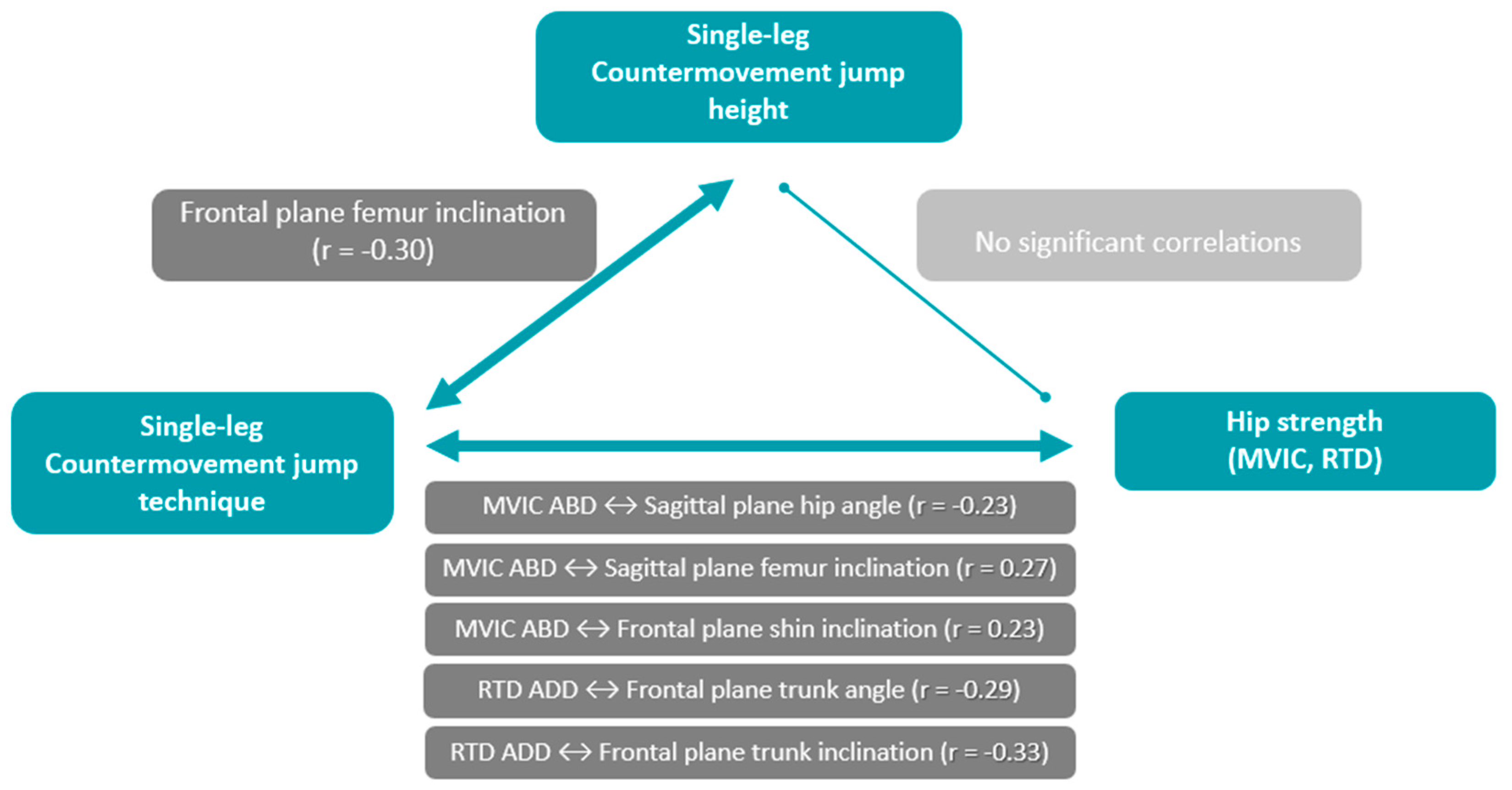Relationship Between Single-Leg Countermovement Jump Height, Technique, and Hip Strength in Elite Handball Players
Abstract
:1. Introduction
2. Materials and Methods
2.1. Experimental Design and Participants
2.2. Testing Procedures
2.2.1. Single-Leg Countermovement Jump Assessment
2.2.2. Isometric Hip Strength Assessment
2.2.3. Single-Leg Countermovement Jump Kinematic Analysis
2.3. Statistical Analyses
3. Results
4. Discussion
4.1. Relationship Between SLCMJ Height and Kinematic Variables
4.2. Relationship Between Kinematic Variables and Maximal and Explosive Hip Strength
4.3. Relationship Between SLCMJ Height and Maximal and Explosive Hip Strength
4.4. Limitations
5. Conclusions
Author Contributions
Funding
Institutional Review Board Statement
Informed Consent Statement
Data Availability Statement
Acknowledgments
Conflicts of Interest
References
- Sleivert, G.; Taingahue, M. The Relationship between Maximal Jump-Squat Power and Sprint Acceleration in Athletes. Eur. J. Appl. Physiol. 2004, 91, 46–52. [Google Scholar] [CrossRef]
- Pleša, J.; Kozinc, Ž.; Šarabon, N. Bilateral Deficit in Countermovement Jump and Its Influence on Linear Sprinting, Jumping, and Change of Direction Ability in Volleyball Players. Front. Physiol. 2022, 13, 768906. [Google Scholar] [CrossRef]
- Bishop, C.; Abbott, W.; Brashill, C.; Turner, A.; Lake, J.; Read, P. Bilateral vs. Unilateral Countermovement Jumps: Comparing the Magnitude and Direction of Asymmetry in Elite Academy Soccer Players. J. Strength Cond. Res. 2022, 36, 1660–1666. [Google Scholar] [CrossRef]
- Bishop, C.; Brashill, C.; Abbott, W.; Read, P.; Lake, J.; Turner, A. Jumping Asymmetries Are Associated with Speed, Change of Direction Speed, and Jump Performance in Elite Academy Soccer Players. J. Strength Cond. Res. 2021, 35, 1841–1847. [Google Scholar] [CrossRef] [PubMed]
- Bobbert, M.F.; Casius, L.J.R. Is the Effect of a Countermovement on Jump Height Due to Active State Development? Med. Sci. Sports Exerc. 2005, 37, 440–446. [Google Scholar] [CrossRef] [PubMed]
- Godinho, I.; Pinheiro, B.N.; Scipião Júnior, L.D.G.; Lucas, G.C.; Cavalcante, J.F.; Monteiro, G.M.; Uchoa, P.A.G. Effect of Reduced Ankle Mobility on Jumping Performance in Young Athletes. Motricidade 2019, 15, 46–51. [Google Scholar] [CrossRef]
- Fischer, F.; Blank, C.; Dünnwald, T.; Gföller, P.; Herbst, E.; Hoser, C.; Fink, C. Isokinetic Extension Strength Is Associated with Single-Leg Vertical Jump Height. Orthop. J. Sports Med. 2017, 5, 2325967117736766. [Google Scholar] [CrossRef]
- Van Hooren, B.; Kozinc, Ž.; Smajla, D.; Šarabon, N. Isometric Single-Joint Rate of Force Development Shows Trivial to Small Associations with Jumping Rate of Force Development, Jump Height, and Propulsive Duration. JSAMS Plus 2022, 1, 100006. [Google Scholar] [CrossRef]
- Dos’Santos, T.; Thomas, C.; Jones, P.A.; Comfort, P. Asymmetries in Single and Triple Hop Are Not Detrimental to Change of Direction Speed. J. Trainology 2017, 6, 35–41. [Google Scholar] [CrossRef]
- Kotsifaki, A.; Whiteley, R.; Van Rossom, S.; Korakakis, V.; Bahr, R.; Sideris, V.; Graham-Smith, P.; Jonkers, I. Single Leg Hop for Distance Symmetry Masks Lower Limb Biomechanics: Time to Discuss Hop Distance as Decision Criterion for Return to Sport after ACL Reconstruction? Br. J. Sports Med. 2022, 56, 249–256. [Google Scholar] [CrossRef]
- Bobbert, M.F.; De Graaf, W.W.; Jonk, J.N.; Casius, L.J.R. Explanation of the Bilateral Deficit in Human Vertical Squat Jumping. J. Appl. Physiol. 2006, 100, 493–499. [Google Scholar] [CrossRef] [PubMed]
- Spudić, D.; Ribič, A. Relationship between Unilateral and Bilateral Countermovement Jump Performance and Force-Velocity-Power Outcome Variables. Kinesiology 2023, 55, 262–269. [Google Scholar] [CrossRef]
- McElveen, M.T.; Riemann, B.L.; Davies, G.J. Bilateral Comparison of Propulsion Mechanics during Single-Leg Vertical Jumping. J. Strength Cond. Res. 2010, 24, 375–381. [Google Scholar] [CrossRef]
- Kozinc, Ž.; Šarabon, N. Measurements of Lower-Limb Isometric Single-Joint Maximal Voluntary Torque and Rate of Torque Development Capacity Offer Limited Insight into Vertical Jumping Performance. Meas. Phys. Educ. Exerc. Sci. 2022, 26, 15–26. [Google Scholar] [CrossRef]
- Kotsifaki, A.; Korakakis, V.; Whiteley, R.; Van Rossom, S.; Jonkers, I. Measuring Only Hop Distance during Single Leg Hop Testing Is Insufficient to Detect Deficits in Knee Function after ACL Reconstruction: A Systematic Review and Meta-Analysis. Br. J. Sports Med. 2020, 54, 139–153. [Google Scholar] [CrossRef]
- Stefanyshyn, D.J.; Nigg, B.M. Contribution of the Lower Extremity Joints to Mechanical Energy in Running Vertical Jumps and Running Long Jumps. J. Sports Sci. 1998, 16, 177–186. [Google Scholar] [CrossRef]
- Wilczyński, B.; Zorena, K.; Ślęzak, D. Dynamic Knee Valgus in Single-Leg Movement Tasks. Potentially Modifiable Factors and Exercise Training Options. A Literature Review. Int. J. Environ. Res. Public Health 2020, 17, 8208. [Google Scholar] [CrossRef] [PubMed]
- Sado, N.; Yoshioka, S.; Fukashiro, S. Free-Leg Side Elevation of Pelvis in Single-Leg Jump Is a Substantial Advantage over Double-Leg Jump for Jumping Height Generation. J. Biomech. 2020, 104, 109751. [Google Scholar] [CrossRef]
- Vadász, K.; Varga, M.; Sebesi, B.; Hortobágyi, T.; Murlasits, Z.; Atlasz, T.; Fésüs, Á.; Váczi, M. Frontal Plane Neurokinematic Mechanisms Stabilizing the Knee and the Pelvis during Unilateral Countermovement Jump in Young Trained Males. Int. J. Environ. Res. Public Health 2023, 20, 220. [Google Scholar] [CrossRef]
- Ueno, R.; Navacchia, A.; DiCesare, C.A.; Ford, K.R.; Myer, G.D.; Ishida, T.; Tohyama, H.; Hewett, T.E. Knee Abduction Moment Is Predicted by Lower Gluteus Medius Force and Larger Vertical and Lateral Ground Reaction Forces during Drop Vertical Jump in Female Athletes. J. Biomech. 2020, 103, 109669. [Google Scholar] [CrossRef]
- Chang, E.; Norcross, M.F.; Johnson, S.T.; Kitagawa, T.; Hoffman, M. Relationships between Explosive and Maximal Triple Extensor Muscle Performance and Vertical Jump Height. J. Strength Cond. Res. 2015, 29, 545–551. [Google Scholar] [CrossRef] [PubMed]
- Tsiokanos, A.; Kellis, E.; Jamurtas, A.; Kellis, S. The Relationship between Jumping Performance and Isokinetic Strength of Hip and Knee Extensors and Ankle Plantar Flexors. Isokinet. Exerc. Sci. 2002, 10, 107–115. [Google Scholar] [CrossRef]
- Harrison, B.; Firth, W.; Rogers, S.; Tipple, J.; Marsden, J.; Freeman, J.A.; Hough, A.D.; Shum, G.L.K. The Relationship between Isokinetic Performance of Hip and Knee and Jump Performance in University Rugby Players. Isokinet. Exerc. Sci. 2013, 21, 175–180. [Google Scholar] [CrossRef]
- Macedo Alfano Moura, T.B.; Alves Okazaki, V.H. Kinematic and Kinetic Variable Determinants on Vertical Jump Performance: A Review. MOJ Sports Med. 2022, 5, 25–33. [Google Scholar] [CrossRef]
- Mcerlain-Naylor, S.; King, M.; Pain, M.T.G. Determinants of Countermovement Jump Performance: A Kinetic and Kinematic Analysis. J. Sports Sci. 2014, 32, 1805–1812. [Google Scholar] [CrossRef]
- Puig-Diví, A.; Escalona-Marfil, C.; Padullés-Riu, J.M.; Busquets, A.; Padullés-Chando, X.; Marcos-Ruiz, D. Validity and Reliability of the Kinovea Program in Obtaining Angles and Distances Using Coordinates in 4 Perspectives. PLoS ONE 2019, 14, e0216448. [Google Scholar] [CrossRef]
- Marušič, J.; Marković, G.; Šarabon, N. Reliability of a New Portable Dynamometer for Assessing Hip and Lower Limb Strength. Appl. Sci. 2021, 11, 3391. [Google Scholar] [CrossRef]
- Maffiuletti, N.A.; Aagaard, P.; Blazevich, A.J.; Folland, J.; Tillin, N.; Duchateau, J. Rate of Force Development: Physiological and Methodological Considerations. Eur. J. Appl. Physiol. 2016, 116, 1091–1116. [Google Scholar] [CrossRef]
- Jaric, S.; Mirkov, D.; Markovic, G. Normalizing Physical Performance Tests for Body Size: A Proposal for Standardization. J. Strength Cond. Res. 2005, 19, 467–474. [Google Scholar] [CrossRef]
- McMahon, J.J.; Suchomel, T.J.; Lake, J.P.; Comfort, P. Understanding the Key Phases of the Countermovement Jump Force-Time Curve. Strength Cond. J. 2018, 40, 96–106. [Google Scholar] [CrossRef]
- Akoglu, H. User’s Guide to Correlation Coefficients. Turk. J. Emerg. Med. 2018, 18, 91–93. [Google Scholar] [CrossRef]
- Kotsifaki, A.; Korakakis, V.; Graham-Smith, P.; Sideris, V.; Whiteley, R. Vertical and Horizontal Hop Performance: Contributions of the Hip, Knee, and Ankle. Sports Health 2021, 13, 128–135. [Google Scholar] [CrossRef] [PubMed]
- De Marche Baldon, R.; Lobato, D.F.M.; Carvalho, L.P.; Wun, P.Y.L.; Presotti, C.V.; Serrão, F.V. Relationships between Eccentric Hip Isokinetic Torque and Functional Performance. J. Sport Rehabil. 2012, 21, 26–33. [Google Scholar] [CrossRef]
- Kariyama, Y.; Hobara, H.; Zushi, K. Differences in Take-off Leg Kinetics between Horizontal and Vertical Single-Leg Rebound Jumps. Sports Biomech. 2017, 16, 187–200. [Google Scholar] [CrossRef] [PubMed]
- Floría, P.; Gómez-Landero, L.A.; Suárez-Arrones, L.; Harrison, A.J. Kinetic and Kinematic Analysis for Assessing the Differences in Countermovement Jump Performance in Rugby Players. J. Strength Cond. Res. 2016, 30, 2533–2539. [Google Scholar] [CrossRef] [PubMed]
- Sánchez-Sixto, A.; Harrison, A.J.; Floría, P. Larger Countermovement Increases the Jump Height of Countermovement Jump. Sports 2018, 6, 131. [Google Scholar] [CrossRef]
- De Bleecker, C.; Vermeulen, S.; De Blaiser, C.; Willems, T.; De Ridder, R.; Roosen, P. Relationship Between Jump-Landing Kinematics and Lower Extremity Overuse Injuries in Physically Active Populations: A Systematic Review and Meta-Analysis. Sports Med. 2020, 50, 1515–1532. [Google Scholar] [CrossRef]
- Pedley, J.S.; Lloyd, R.S.; Read, P.J.; Moore, I.S.; De Ste Croix, M.; Myer, G.D.; Oliver, J.L. Utility of Kinetic and Kinematic Jumping and Landing Variables as Predictors of Injury Risk: A Systematic Review. J. Sci. Sport Exerc. 2020, 2, 287–304. [Google Scholar] [CrossRef]
- Bakker, R.; Tomescu, S.; Brenneman, E.; Hangalur, G.; Laing, A.; Chandrashekar, N. Effect of Sagittal Plane Mechanics on ACL Strain during Jump Landing. J. Orthop. Res. 2016, 34, 1636–1644. [Google Scholar] [CrossRef]
- Kotsifaki, A.; Van Rossom, S.; Whiteley, R.; Korakakis, V.; Bahr, R.; Sideris, V.; Jonkers, I. Single Leg Vertical Jump Performance Identifies Knee Function Deficits at Return to Sport after ACL Reconstruction in Male Athletes. Br. J. Sports Med. 2022, 56, 490–498. [Google Scholar] [CrossRef]
- Podraza, J.T.; White, S.C. Effect of Knee Flexion Angle on Ground Reaction Forces, Knee Moments and Muscle Co-Contraction during an Impact-like Deceleration Landing: Implications for the Non-Contact Mechanism of ACL Injury. Knee 2010, 17, 291–295. [Google Scholar] [CrossRef]
- Martinez, A.F.; Lessi, G.C.; Carvalho, C.; Serrao, F.V. Association of Hip and Trunk Strength with Three-Dimensional Trunk, Hip, and Knee Kinematics during a Single-Leg Drop Vertical Jump. J. Strength Cond. Res. 2018, 32, 1902–1908. [Google Scholar] [CrossRef]
- Patti, A.; Gervasi, M.; Giustino, V.; Figlioli, F.; Canzone, A.; Drid, P.; Thomas, E.; Messina, G.; Vicari, D.S.S.; Palma, A.; et al. The Influence of Ankle Mobility and Foot Stability on Jumping Ability and Landing Mechanics: A Cross-Sectional Study. J. Funct. Morphol. Kinesiol. 2024, 9, 160. [Google Scholar] [CrossRef] [PubMed]
- Maćkała, K.; Fostiak, M.; Kowalski, K. Selected Determinants of Acceleration in the 100m Sprint. J. Hum. Kinet. 2015, 45, 135–148. [Google Scholar] [CrossRef] [PubMed]
- Francis, P.; Gray, K.; Perrem, N.; Driban, J.B. The Relationship between Concentric Hip Abductor Strength and Performance of the Y-Balance Test (YBT). Int. J. Athl. Ther. Train. 2018, 23, 42–47. [Google Scholar] [CrossRef]
- Lanza, M.B.; Rock, K.; Marchese, V.; Addison, O.; Gray, V.L. Hip Abductor and Adductor Rate of Torque Development and Muscle Activation, but Not Muscle Size, Are Associated with Functional Performance. Front. Physiol. 2021, 12, 744153. [Google Scholar] [CrossRef]
- Santana, J.C.; McGill, S.M.; Brown, L.E. Anterior and Posterior Serape: The Rotational Core. Strength Cond. J. 2015, 37, 8–13. [Google Scholar] [CrossRef]
- Haksever, B.; Micoogullari, M.; Soylu, C.; Baltaci, Y.G. Does Gluteus Medius Muscle Strength Affect Balance and Jumping Performance in Elite Female Handball Players? Sci. Sports 2022, 37, e1–e151. [Google Scholar] [CrossRef]
- Kollock, R.; Van Lunen, B.L.; Ringleb, S.I.; Onate, J.A. Measures of Functional Performance and Their Association with Hip and Thigh Strength. J. Athl. Train. 2015, 50, 14–22. [Google Scholar] [CrossRef]
- Nuzzo, J.L.; Mcbride, J.M.; Cormie, P.; Mccaulley, G.O. Relationship between Countermovement Jump Performance and Multijoint Isometric and Dynamic Tests of Strength. J. Strength Cond. Res. 2008, 22, 699–707. [Google Scholar] [CrossRef]
- Suchomel, T.J.; Sole, C.J.; Bellon, C.R.; Stone, M.H. Dynamic Strength Index: Relationships with Common Performance Variables and Contextualization of Training Recommendations. J. Hum. Kinet. 2020, 74, 59–70. [Google Scholar] [CrossRef] [PubMed]
- Impellizzeri, F.M.; Rampinini, E.; Maffiuletti, N.; Marcora, S.M. A Vertical Jump Force Test for Assessing Bilateral Strength Asymmetry in Athletes. Med. Sci. Sports Exerc. 2007, 39, 2044–2050. [Google Scholar] [CrossRef] [PubMed]





| Test | Variable Name | Mean (SD) | Maximum | Minimum |
|---|---|---|---|---|
| SLCMJ | Height (m) | 0.18 (0.03) | 0.26 | 0.12 |
| Hip MVIC variables | Abduction (Nm/kg0.67) | 8.51 (1.59) | 12.67 | 4.73 |
| Adduction (Nm/kg0.67) | 9.90 (2.27) | 16.50 | 3.52 | |
| Flexion (Nm/kg0.67) | 10.10 (2.23) | 15.17 | 2.68 | |
| Extension (Nm/kg0.67) | 10.09 (2.31) | 15.65 | 3.90 | |
| Hip RTD variables | Abduction (Nm/kg0.67/s) | 34.59 (18.56) | 85.70 | 2.73 |
| Adduction (Nm/kg0.67/s) | 44.49 (22.24) | 98.34 | 3.64 | |
| Flexion (Nm/kg0.67/s) | 59.68 (33.00) | 158.71 | 5.84 | |
| Extension (Nm/kg0.67/s) | 38.99 (22.18) | 104.52 | 1.74 | |
| Sagittal plane kinematic variables | Knee angle (°) | 113.95 (6.78) | 131.67 | 99.18 |
| Hip angle (°) | 108.06 (10.02) | 144.08 | 93.06 | |
| Shin inclination (°) | 30.98 (3.54) | 40.64 | 25.43 | |
| Femur inclination (°) | 35.21 (5.54) | 47.82 | 18.93 | |
| Trunk inclination (°) | 38.31 (9.23) | 63.52 | 13.02 | |
| Frontal plane kinematic variables | Knee angle (°) | 172.14 (4.87) | 178.76 | 159.15 |
| Hip angle (°) | 77.02 (11.33) | 88.83 | 21.88 | |
| Trunk angle (°) | 110.98 (14.38) | 169.87 | 91.61 | |
| Shin inclination (°) | 6.69 (4.13) | 19.06 | 0.55 | |
| Femur inclination (°) | 8.91 (4.85) | 19.86 | 0.17 | |
| Pelvis inclination (°) | 81.86 (11.74) | 89.62 | 26.37 | |
| Trunk inclination (°) | 21.15 (12.88) | 71.53 | 5.10 |
Disclaimer/Publisher’s Note: The statements, opinions and data contained in all publications are solely those of the individual author(s) and contributor(s) and not of MDPI and/or the editor(s). MDPI and/or the editor(s) disclaim responsibility for any injury to people or property resulting from any ideas, methods, instructions or products referred to in the content. |
© 2025 by the authors. Licensee MDPI, Basel, Switzerland. This article is an open access article distributed under the terms and conditions of the Creative Commons Attribution (CC BY) license (https://creativecommons.org/licenses/by/4.0/).
Share and Cite
Spudić, D.; Ribič, A.; Šarabon, N.; Pori, P. Relationship Between Single-Leg Countermovement Jump Height, Technique, and Hip Strength in Elite Handball Players. Appl. Sci. 2025, 15, 4651. https://doi.org/10.3390/app15094651
Spudić D, Ribič A, Šarabon N, Pori P. Relationship Between Single-Leg Countermovement Jump Height, Technique, and Hip Strength in Elite Handball Players. Applied Sciences. 2025; 15(9):4651. https://doi.org/10.3390/app15094651
Chicago/Turabian StyleSpudić, Darjan, Ažbe Ribič, Nejc Šarabon, and Primož Pori. 2025. "Relationship Between Single-Leg Countermovement Jump Height, Technique, and Hip Strength in Elite Handball Players" Applied Sciences 15, no. 9: 4651. https://doi.org/10.3390/app15094651
APA StyleSpudić, D., Ribič, A., Šarabon, N., & Pori, P. (2025). Relationship Between Single-Leg Countermovement Jump Height, Technique, and Hip Strength in Elite Handball Players. Applied Sciences, 15(9), 4651. https://doi.org/10.3390/app15094651








